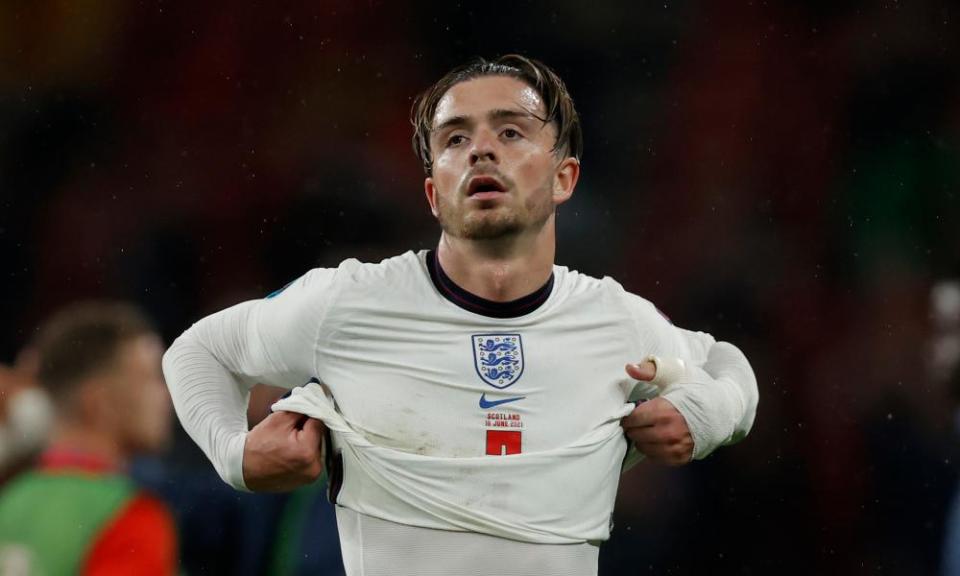Harry Kane left looking out of place as system built around him fails to click
Perhaps it really was the end times. Perhaps it really was the nadir. Perhaps it really was the worst England performance we had seen in a generation. Certainly it will feel that way to Gareth Southgate and his team as they awaken this morning to the scalding verdict of a scornful nation, still seething at being forced to give up a perfectly good Friday night for that.
It wasn’t an awful game, as such. But given the froth and bubble of the buildup, it felt just a little hollow, a little oversold: like the slap-up meal that ends up being served to you in a Styrofoam box. Above all it was a messy and disjointed match, hardly helped by an officious Spanish referee under the apparent impression that the point of football is to win as many free-kicks as possible.
Related: England frustrated by steely Scotland in Euro 2020 stalemate at Wembley
Naturally, this was more to Scotland’s liking than to England’s. Indeed, Steve Clarke’s team pretty much fulfilled their gameplan to the letter: squeezing England’s space when they were out of possession, providing sufficient angles and options in it. Indeed had they converted their half-chances they might even have nicked a win, and in his post-match debrief Clarke may well wonder whether he could even have been a little braver in the second half.
At which point, it is probably worth putting things into a little perspective. For all the frustration and rage that will be emptied onto this England team in the coming days, it’s worth remembering that they are still virtually guaranteed qualification to the knockout stages. If they finish runners-up in the group, they may yet avoid a tricky meeting with France, Portugal or Germany. As in Russia three summers ago, there is still an opportunity to build momentum from an underwhelming group stage.
And by the same token two clean sheets and few serious alarms at the back: for a team whose defence was assumed to be its soft centre going into the tournament, England have looked solid enough under pressure. Tyrone Mings and the ever-maligned Jordan Pickford have actually been two of their better performers. Mason Mount has carried his club form into international colours. The problem is, so have most of his teammates.
Yes: it’s time to talk about that front three. A front three that have now mustered one goal and three shots on target in 180 minutes of tournament football. Here, the various constituent parts of England’s attack – Harry Kane, Phil Foden, Raheem Sterling, Marcus Rashford and Jack Grealish – mustered three shots between them. Che Adams, meanwhile, had five on his own.
Numbers don’t tell the full story here, of course. Rather, the problem with England’s attack is one of tone as much as volume: the sense of pieces not quite fitting, pieces jamming into other pieces, pieces misshapen and misused to the point where you’re not quite sure what they were originally for. Is Sterling a dribbler, a creator or a finisher? Is Foden’s main job to play cute through balls or to chase them? And just what, exactly, is Kane supposed to be these days?

In striving to play his dual No 9/No 10 role while clearly not at his physical peak, Kane has somehow ended up playing neither. He slowed attacks down when he dropped deep. He was painfully off the pace when the ball was delivered into the penalty area. And for much of the interim periods he simply existed, like a faint outline of a former threat: a giant boar’s head mounted above the threshold in the hope that it might scare burglars.
Related: England 0-0 Scotland: Euro 2020 player ratings from Wembley
There was a moment just before half-time when Foden plonked a cute diagonal ball over the top for Kane to chase. A few strides into a deeply mismatched race with Kieran Tierney it became clear not only that Kane was not going to reach the ball first, but that given a clear run and a limitless amount of pitch he might struggle to reach the ball at all. At his very best Kane is a throbbing, restless presence: right now he looks like a man not only struggling to get the ball out from under his feet, but also at times struggling to get his feet out from under his ankles.
Clearly there are auxiliary issues at play here: quality of service, movement around him, full-backs who can make more than – say – one correct decision in every three. But an underperforming Kane is more serious to England than a regular underperforming player, by simple dint of the fact that their entire system is essentially built around him. This is Kane’s team, and arguably has been for most of Southgate’s five years in charge.
Take the example of Grealish, who made his bow on the hour like some heroic king in exile. The absence of Grealish has irked many, but with Kane in his hybrid role, you need runners with pace in behind to complement him. Small wonder that when he did arrive, Grealish found himself running into the same constricted spaces as everyone else.
So it was a quietly significant moment when, 16 minutes from time, Southgate decided he had seen enough. After 19 touches and seven completed passes, off came Kane. And although it changed little in terms of the result, it was a sign that Southgate sees an attacking vision of England in which his captain is no longer present. The real question, of course, is whether he has the remotest idea what it looks like.

 Yahoo Movies
Yahoo Movies 
